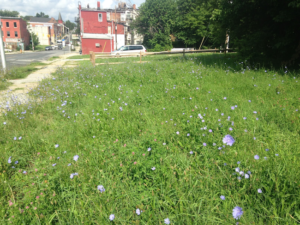
Plant diversity in a vacant lot in Baltimore, MD, USA.
Credit: Dr. Anna L. Johnson
If you live in a city, chances are you’ve seen an abandoned lot or two. While urban dwellers may not immediately think of vacant lots as harboring rare species and scenic natural vistas, they are are often candidates for urban conservation, restoration, or greening projects.
The success of such projects depends on understanding what processes control plant diversity and composition in urban areas. In a recent study researchers with the Baltimore Ecosystem Study Long Term Ecological Research Network (BES-LTER) found that variations in prior land use, even within different sections of the same lot, caused plant communities to diverge in plant composition and characteristics over time.
The researchers assessed how plant diversity, seed dispersal mechanisms, and establishment and persistence traits of plant species changed over time by surveying 29 vacant lots ranging in age from 3 to 22 years since abandonment. Plant diversity within each vacant lot was assessed by splitting lots into sections where buildings previously stood (building footprint) and where the garden or backyard previously stood (remnant garden).
Plant species diversity and persistence and establishment traits did not change much over the 22-year time frame. However, researchers found that seed dispersal strategies became increasingly different over time in building footprints and remnant gardens within the same vacant lot. This suggests that over time, sections of the lot that have different land use histories can develop different plant colonization patterns, eventually changing plant community assembly and diversity within each plot.
The spatial and temporal variations in plant community diversity in vacant lots indicates that different land use patterns within small urban patches can increase urban biodiversity. By understanding how urban ecosystems respond to human activities, these scientists are helping land use managers make decisions that are beneficial for both humans and urban wildlife.
-Alex Jamis
Source: Johnson et al. Journal of Applied Ecology. 2017. Land use history and seed dispersal drive divergent plant community assembly patterns in urban vacant lots. DOI: 10.1111/1365-2664.12958










